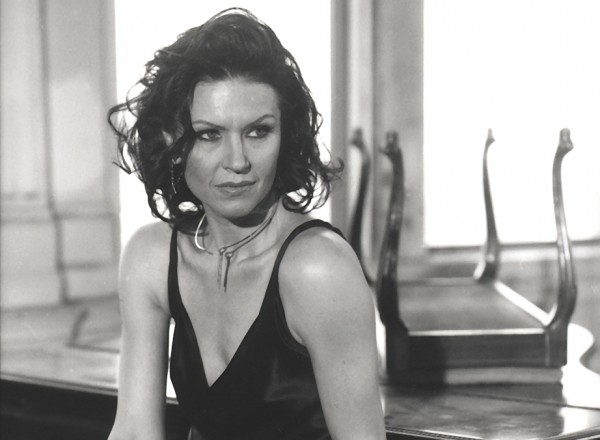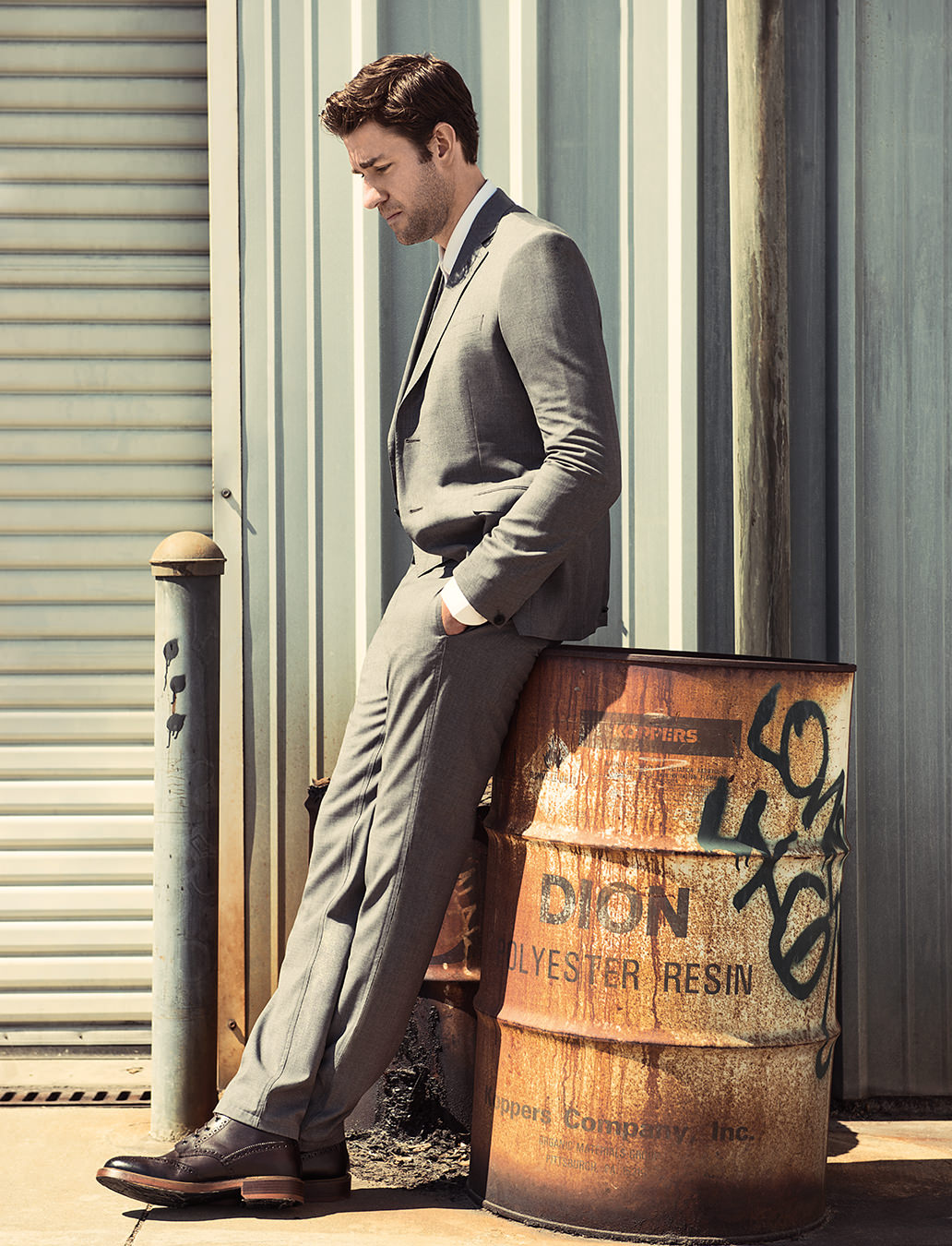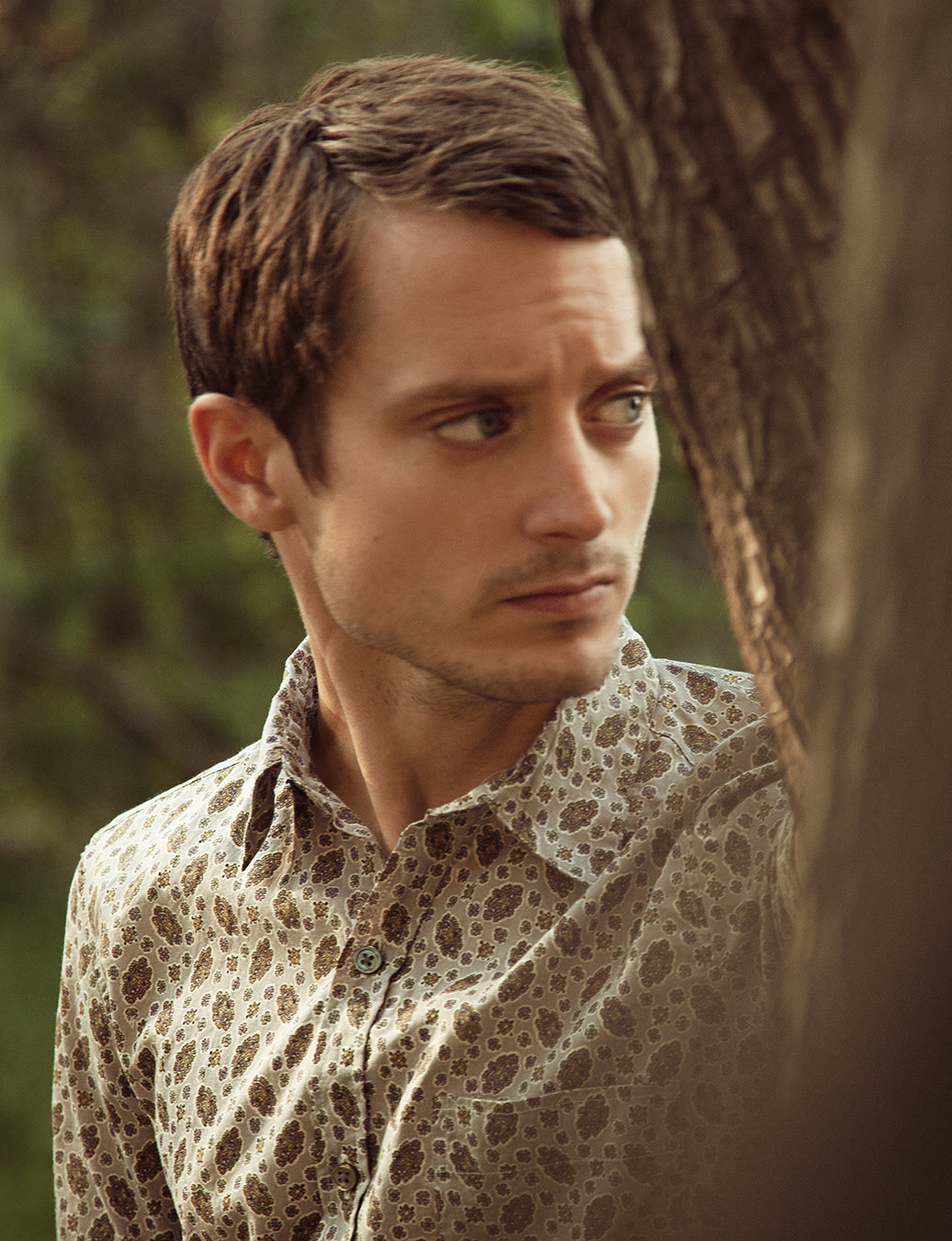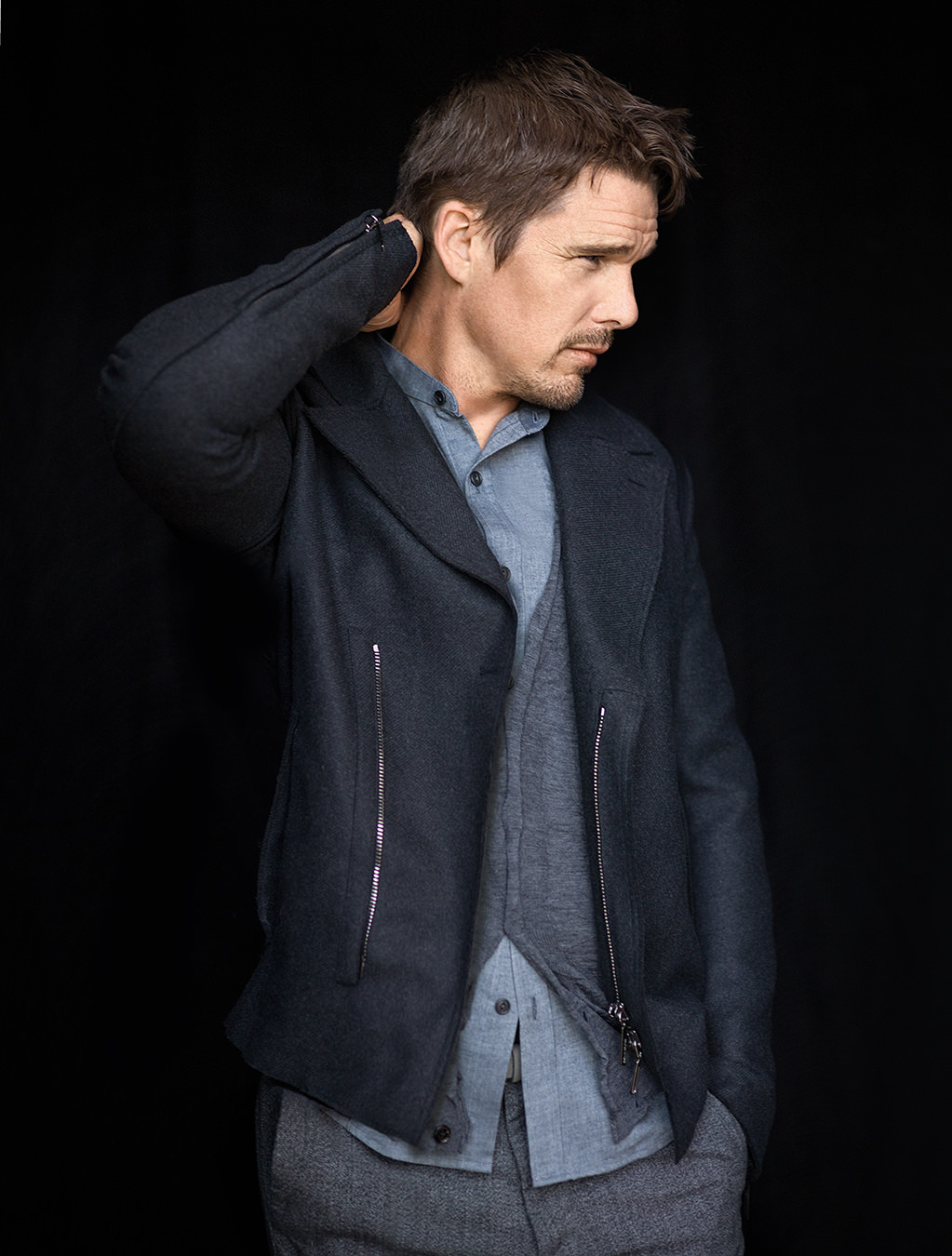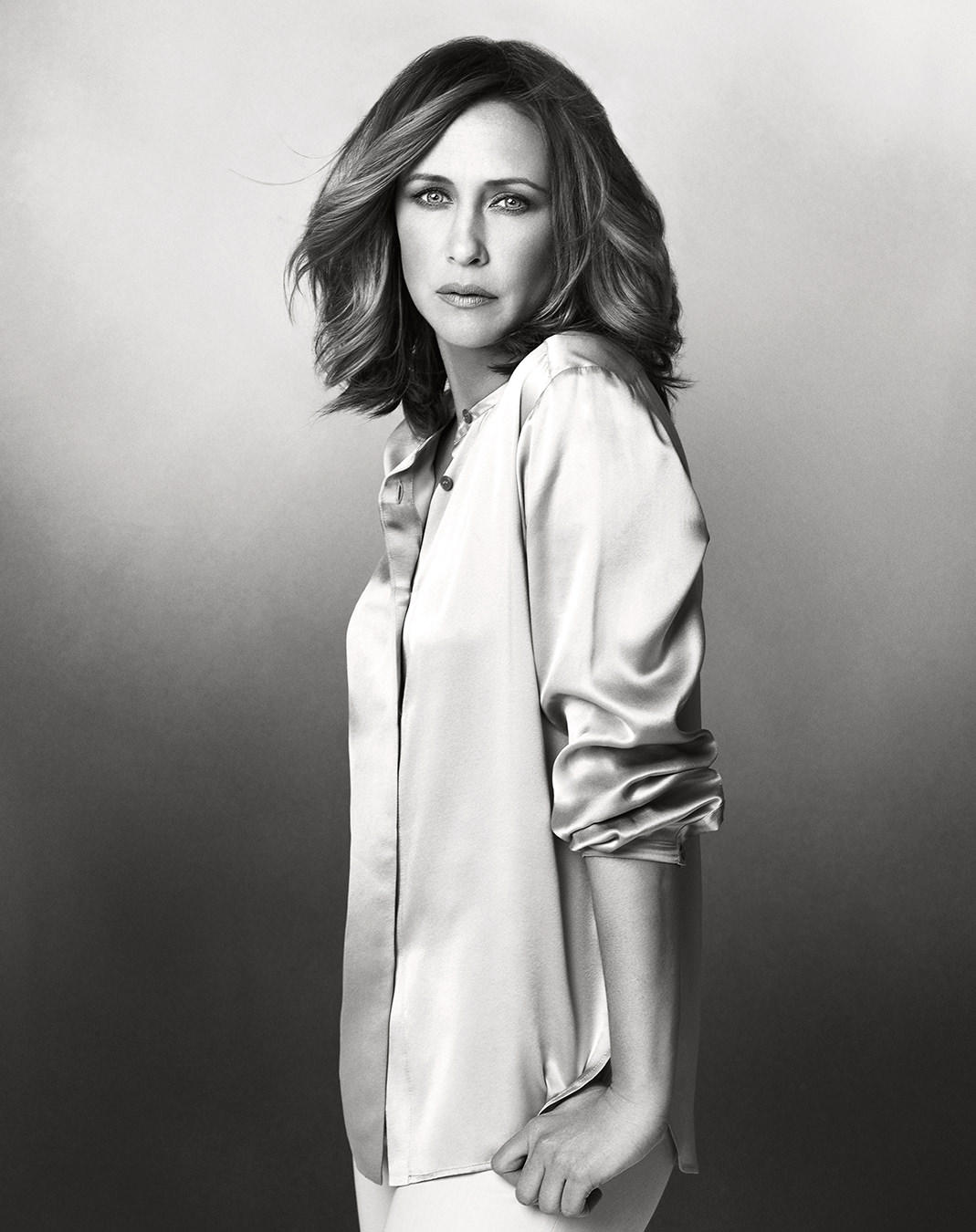Suddenly Wendy
Wendy Crewson speaking her mind.

Strong but vulnerable. It is ostensibly a segue into a multi-dimensional female supporting role. But, maybe not. Try two-dimensional, a thinly veiled work of commercial chauvinism. Actor Wendy Crewson provides insight into this Hollywood blockbuster stereotyping of women. Her views combine a hard-edged realism and the strength of optimism. She discusses along the way the state of women in film, the Canadian notion of celebrity, and she elaborates on the absence of proper promotion in Canadian Cinema. She also has clear views on how to actually take some action against these challenges.
Her manner is direct and uncensored. She walks in for the first interview casually, yet with an armload of energy. She possesses a self-awareness and humility that typically read as the Canadian trademark for self-deprecation. Not an accurate read on her, though. Wendy Crewson works as an actor, but all that surrounds that notion (fame, money, ego even) never come into play when with her. She could just as easily be describing her work as a teacher or entrepreneur. The singular trait: they require passion to execute well.
Crewson is looking for challenges when she selects roles. She obtained a formal academic background with a Bachelor of Arts from Queen’s University and then pursued a post-graduate degree from the Webber Douglass Academy in London and the American Repertory Theatre. Not the story of a starry-eyed ingénue trying to make her break in Hollywood. Despite the perception that acting is an emancipated field of work, it is not the playground for intellectual women, particularly for women looking for roles in successful commercial vehicles.
Her view on the nature of the roles available to women in these films is both good-natured and searing. The woman has a palpable edge. Wendy encounters the “strong but vulnerable” epitaph far too often. “If I see that one more time I’ll puke,” she laughs. The problem is that “it doesn’t ruffle any feathers. You know; the generic nice woman in the movie marriage.” This Hollywood cliché is damaging. It purports a female ideal that was not created by women, though it has long been under scrutiny by the second sex. At the core of this standard is the assumption that a woman has no true strength; inevitably she will collapse under her own vulnerability. It is a myth in the culture at large, which then serves to justify keeping women in this pitiable role. Hollywood plays its part in the myth-making machine.
Another consequence of the infamous “strong but vulnerable” descriptor is that it sentences a female actor to oodles of screen time, with no other purpose than to ‘support’ her male lead. “In Air Force One I spoke like four times. I was in practically all the scenes, doing a lot of emoting and ‘supporting’. The same with Williams and Schwarzenegger (Bicentennial Man and The Sixth Day) I’m in the scene but not doing anything.” Part of the myth making is to acknowledge the female presence but to reduce her status to irrelevance.
Crewson’s roles in Better Than Chocolate and Suddenly Naked provided the opportunity to explore less conventional characters. In Suddenly Naked she plays Jackie York, who explores the older woman/younger man paradigm. “She’s loud, self-important and behaves like a 14 year old . . . she has sex indiscriminately, falls in love with a younger man. I don’t see those characters in the big American films.” These women are not overtly likeable and do not conform to traditional conventions. Crewson finds that these smaller projects offer opportunities she has yet to find in Hollywood.
Her views on the studio system underline why she finds that the “small films are still the most fun to do.” Male roles continue to outnumber female roles, with age continuing to be an ever present factor in a woman’s cachet. Crewson faces this with a startling amount of humour and optimism. “I look for character driven scripts I can relate to or that reflect my life. Well, at least for female roles where the women aren’t 21. Women of 45 are not typically in the movies.” Regardless, she understands the economy she has invested in and plays as she should to advance her career.
She does not restrict her voice nor is she afraid to comment on the nature of the business. Far from being co-opted into the system she is attempting to penetrate, Crewson’s anecdotes are poignant yet continually infused with a humour that comes from wise detachment. There is interplay between her active participation in and her ironic distance from celebrity. She prepares for our photo shoot to accompany this piece, a recreation of the “glamour girl” of the golden studio years. That makes what is next on her agenda even more interesting: an audition in L.A. “It’s the same old, same old,” she begins. “It’s a film with Gene Hackman where he plays the ex-president, and I’m auditioning to be his secretary. He’s recently divorced and completely unable to cope on his own, she’s secretly in love with him but he doesn’t see her because she’s under his nose. Comedic hijinx ensue as they move to a small town and end up together.” This precis relates well to what Wendy refers to as the sit-com-ing of film.
Wendy does not restrict her voice nor is she afraid to comment on the nature of the business.
She expresses a concern over a particular movement in the studio system that appears to be lowering the bar. “Studios now take a script, give it 100 rewrites and then test the idea and homogenize it down to the purest copy of the big time and then hire a first time director they can manipulate to make it.” She understands the machine but her incisive assessment goes much deeper than a commentary on the quality of plot development. She sits in the dressing room and becomes Rita Hayworth; it is significant that the story she narrates is one that may have been tacitly understood by Hayworth herself but never spoken.
She continues with her story: “I have to put on my little dress and high heels and schmooze the guys at the studio, convince them that I’m ‘big’ enough to carry this little, tiny role opposite Gene whose 70! I’ve played opposite Harrison Ford as his wife and I have to convince them I can play a 70 year old’s secretary.” Her face breaks into a smile. Her gregarious and affable attitude are what make such a situation hilarious. It illustrates a fundamental part of who she is: Crewson is entirely devoid of any pretense when discussing her work. She can enjoy the glamorous veneer without losing perspective. The darker side of it, however, is that being forced to participate in such a system makes the power issues an undeniable reality.
Nevertheless, her optimism is unfailing. She concurrently feels a sense that more roles are being commanded by strong women. “There are more and more women’s roles. Sarandon, Lange, Streep are all in their 40s and 50s. These women demand a certain role and have a presence to be reckoned with.” Of her co-star Sophia Loren in Eduardo Ponti’s Between Strangers, she makes a similar assessment: “Sophia is an icon of beauty that sails in with such grace. Every movement possesses this. She is timeless.” Her final analysis is that adult “women are getting roles and it is heartening.” Despite the realities of the auditions and the Faustian dilemma clearly presented within celebrity culture, Crewson’s overarching position is buoyant, forward-looking and constructive.
Her unaffected approach is reinforced by her motivations as an actor. “In order to make $150M on opening night, the film must appeal to the broadest audience with disposable income—this being young males who take their girlfriends. I’m not really interested in making movies for the 18-35 year old male demographic.” This is at the heart of Crewson’s understanding of her business. Although these may not be the roles which inspire her as an artist, they are roles which she pursues and which she is talented enough to get. Just this past May she acted in the newest Colin Farrell vehicle, A Home at the End of the World written by Michael Cunningham, screenwriter of The Hours. “It was shot in Toronto. I play Colin’s mother. This is what it comes to. He should be so lucky,” she bursts into a hearty giggle. “Well, okay, in flashbacks, when the character is supposed to be nine years old.” This is what makes Crewson so physically vivid, and real; her humility precludes her from admitting she was cast because the director thought she was a “babe”. These types of roles are a matter of course for Crewson. She never once undermines their part in her career.
She is also astutely aware of the obstacles regarding these types of roles. Her approach, however, is dispassionate and considered. “You can never make too many blockbusters,” she comments bluntly and laughs. “It’s what allows me to accept the interesting roles I’m offered here in Canada. I mean where would I have the opportunity to do a dildo scene like the one in Better than Chocolate?” Her supporting female lead roles in Hollywood have given her the celebrity these interesting projects never could. Air Force One opposite Harrison Ford, The Sixth Day opposite Arnold Schwarzenegger, What Lies Beneath again opposite Harrison Ford and Michelle Pfeiffer and To Gillian on Her 37th Birthday opposite Michelle Pfeiffer and Peter Gallagher have made her bankable. And it is this duality that Crewson firmly grasps and uses to her advantage.
She pursues this line of reasoning further to uncover, in the process, her own ambitions within that system. She understands the need to star in the Hollywood project. In fact, “I wish I had more star power to bring to Canadian films.” She uses the double-edged sword to cut in her favour. “It is always more interesting without the gloss but without the star a film faces the long road of festivals, which can then take years to sell. You need someone big to propel it through. It would be nice to have that kind of star power for Canadian films.”
She clearly comprehends the strength of star power and comments widely on the necessity for the promotional and marketing arms of the industry. “I don’t mind it. A very important part of the business is promoting the product and it is my job as much as the acting is. Harrison Ford told me ‘that’s what they pay me for, the acting is fun’.” It is in fact this aspect which allows the American blockbuster to draw strength.
She appreciates the advantages of this corporate vision. Simply put, filmmaking is a business venture and the role of the marketer is to sell that film. This is virtually absent in Canadian film. In Crewson’s analysis, it is at the heart of why Canadian Cinema and talent are often ignored. “There is a lack of willingness to promote ourselves and we are hypercritical, which defeats the industry. In Quebec there isn’t this same inhibition.” She continues, “The [English] Canadian film has been trying to find its voice, it’s a debate that has been going on for years and years—why do American films flourish or Quebec films for that matter—why do we stand in a shadow?” One answer may be the very nature of what it means to be a Canadian star, if such a thing exists. In Crewson’s view there is “no such thing as fame. There is a sense of decorum [in Canada]—we don’t just run up to people, that’s not acceptable to do. That kind of fame is seen as distasteful.” She is also aware of the advantages of the Canadian reality, and embraces them emphatically. “It can serve to create an environment where people take small budgets and tight schedules and create something which results in a statement without homogenizing. There is no time or money for focus groups or over-thinking. You get a purer art form that is closer to a director’s vision. Unlike the corporate vision in the States.” If you achieve something like a star system in Canada, box office success could follow, without the compromise of losing cultural integrity.
Besides, wouldn’t it be nice to cast a Canadian star with mega-wattage in homegrown features? Wouldn’t it be nice not to have to worry that using Canadian money in the film would decrease it’s marketability in the only money market that seems to matter? Wouldn’t it be nice to show some Canadian films on Canadian airlines without worrying that it may incite a passenger revolt? (Final scenario not hypothetical; witnessed by yours truly.)
These are challenges that actors like Crewson, directors, and producers in Canada have to face, all the while attempting to increase the visibility of this country’s cinema. What, if any, will the compromises be? The truth about Canadian Cinema is, that of an already small budget, virtually none of it goes into promotion. Crewson elaborates on this point. “It was nice to see finally in Men with Brooms some money being spent on advertising and marketing.” She further discusses our own awkwardness towards our work: “There can be that tendency to look upon our own product as less. Look at Suddenly Naked. We took it to Los Angeles this past March and opened it at the Laemmle’s Sunset 5. It is known for quirky indie films; it opened to great reviews in L.A. Weekly. Take it out of context and it’s refreshing.” Take the Canadian product outside of the country and suddenly it becomes exotic, foreign, art-house. Why it is not refreshing in context is baffling, because Canadian film certainly isn’t mainstream, even in Canada.
The variable factor which Crewson highlights regarding this U.S. premiere as opposed to the quiet run the film had in Canada is that there was money spent on the marketing prior to the opening: “Our public relations firm took out a full-page ad in Variety with quotes from our reviews as a means to promote the film. They understand the machine in the States.” It actually doesn’t take much to make these films commercially viable, albeit an entirely different venture from the blockbuster. Our cultural endeavours are not constructed to be compared to the box offices revenues of a Maid in Manhattan. They actively participate in the culture, and try to make their money back. Crewson’s one darker observation: “Do we have a movie going public in the same way the French do for example, with as sophisticated a portion of the public? Or is there too much American product in our market that just appeals to the rest?” The answer is almost irrelevant, because Crewson and others like her are out in the field planting their seeds regardless of whether the rain will come or not.
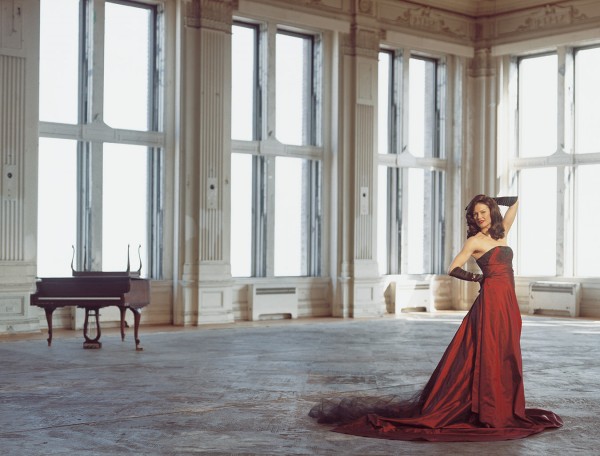
Thien Le bustier gown; 18-karat gold and diamond bangle from the Vento Incontri Collection; 18-karat gold and diamond necklace from the Vento Bonsai Collection.
Wouldn’t it be nice to cast a Canadian star with mega-wattage in homegrown features?
Crewson has a fervent belief in the potential of the Canadian Cinema. She also takes the social responsibilities of her work home with her. She is one who invests in her work and her characters, more than just during the film take. She does not do this, however, by inflicting the idiosyncracies of her film character on the crew after a scene ends; rather she keeps thinking about the impact of her work in a more tangible way. She shares what she experienced during her portrayal of Sue Rodriguez in At the End of the Day: The Sue Rodriguez Story: “I feel responsible in the circle of political and social issues. It’s hard not to feel it. It would seem irresponsible to invest in the character of Sue Rodriguez for the movie and then to never think about the disease again. I felt a responsibility to Sue but also felt a connection to her family.” Sue Rodriguez was a victim of ALS, amyotrophic lateral sclerosis, and fought for the right to assisted suicide from 1992-93 and eventually lost. These are serious issues. Crewson embraces them in her daily life rather than relinquish any attachment once the film is over.
Her philanthropic work is exemplary and her investment in what she considers her social responsibility is considerable. “I was invited by a group in Alberta that was doing some fundraising. I got involved on a national level to raise public awareness for fundraising efforts. ALS doesn’t have a high profile and suffers as a result. The illness is terminal and there is no cure.” She became national spokesperson for ALS in 1999 after her role as Sue Rodriguez. Her dedication and work with the ALS foundation led to a Gemini Humanitarian Award in 2002.
This also applies to The Many Trials of One Jane Doe. This film is the true story of a woman who sued the Toronto police force for using her as bait in a serial rapist case in the mid 80s, and for endemic and systemic sexism within the force. The final verdict was read in 1998, which held that the Toronto police force had violated her constitutional rights. An audit was ordered into the nature of sexual assault investigations in general. (As of 2002, Jane Doe contends that many of the recommended changes have not been implemented.) Crewson herself is an informed advocate for the cause: “Rape is treated on the same level as a misdemeanour; only six percent of rapes are actually reported because women are afraid to go to the police. It’s seen as accidental intercourse and Jane Doe’s rape, which was at knife point, was categorized as a non-violent rape,” an absurdity if there ever was one. That such a classification exists is the very definition of sexism.
“Jane Doe refused to be a victim and made a ton of enemies along the way because she was so focused on her vision. I met her to discuss what had happened. The most telling was her description of how she reported the rape. ‘I was calm and precise, I was reporting a rape,’ she told me.” And this is exactly what Crewson brought to the role. It is a brutal two hours to watch and absolutely horrifying to think that this is Canada, in the 21st century. To see her as Jane Doe and then to see her performance in Better Than Chocolate is to understand Crewson’s own complex character. She has a versatility that makes her a good actor, and which informs her sharp insights. What Crewson does with the Jane Doe role is to take a real person and in effect invert the strong but vulnerable archetype. Her portrayal of a vulnerable but essentially strong woman is compelling and difficult to watch. It is a reality that exists but that is rarely depicted.
Her guiding principle is that of action, whether in the roles she selects, the causes she supports, or the community she participates in building. It is what has most likely brought her and other like minded individuals to initiate a co-operative that could potentially rearrange the conventions of bringing a film to theatrical release. “We are trying to form a movie co-op where we get talent, writers, directors, crew, producers, managers who invest their skills and time. We all own shares in the film and then take our cut of the profit. With all the cuts and so little assistance, the tax breaks are only for U.S. films so we thought how do we get around the problem?” The idea has brought together George Bloomfield, Luisa Varlatta, Maury Chaykin, Peter Outerbridge, Alyson Feltes, Jaime Paul Rock, and Perry Zimel. Together they are creating enough footage of a screenplay entitled Mozart Loves Me that they can use to sell the script and idea. Kodak has donated film; equipment and crew have all been donated or sponsored. The concept in itself creates a buzz because production has already begun. More importantly, it provides the distributors with something tangible to preview.
We move upstairs to the abandoned Crystal Ballroom of the King Edward Hotel to shoot Wendy à la Hayworth, participating in a type of culture-building. That a huge talent pool exists in Canada is undeniable; that there is a simmering creative force within our borders is evident. It seems fitting that Wendy, unlike her predecessors, has a large part in the creation of her image. She is working the system from the inside. Strong yet vulnerable should amount to much more than the usual fare served up in the Hollywood blockbuster. Suddenly Wendy finds herself in a position to prove this, on the Canadian landscape and beyond.
Direction and styling: Luisa Rino
Hair, wig, and make-up: Kiril Mumdjiev for Holt Hair, Toronto
Cosmetics: Laura Mercier
Photography assistance: Tracy Shumate
Production assistance: Esther Choi
Shot on location at Le Royal Meridien King Edward Hotel, Toronto.
Pictured in first image: David Dixon skirt; Arctic Fox stole by Bell Furs; suede gloves Hugo Boss Woman; tanzanite and diamond necklace and sapphire diamond earrings handcrafted by Jeffrey Miller for Montecristo Jewellers; and Falcinelli diamond ring.

